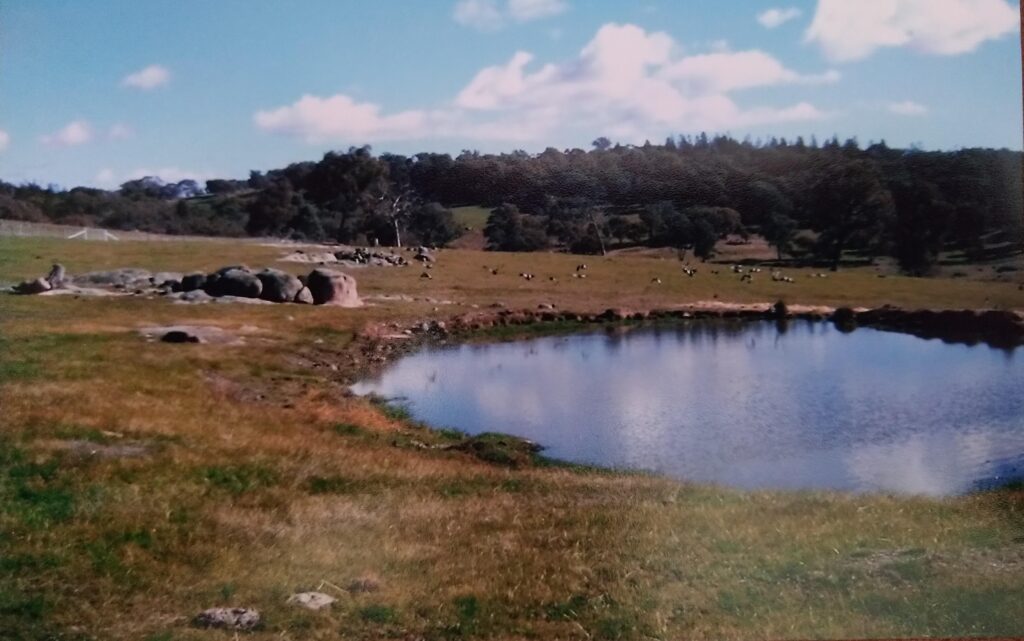Conservation at Vinelea
We aim to leave our small part of the world in a better state than we found it, and that means it should be healthier, more resilient, with greater biodiversity and more physically attractive. We are doing this simply because we feel it is the right thing to do, and that it is up to individuals to do what each of us can to fix the climate problems of the world.
In 2005 we purchased the property that is now Vinelea, and at that time it was a degraded, ‘subsistence farming’ block, where generations of owners had done little more than install fences, graze sheep and cattle and cut down trees. Prior to that, the creek and valley to the south and west had been extensively altered by gold mining in the 1850s. It was a mess, but in a beautiful valley; it just needed a chance to recover.
The native state before the arrival of white settlers would have been extensive, open, dry-sclerophyll forest, with a healthy population of kangaroos, wallabies, echidnas, wombats, goannas, a range of native birds and all of the smaller animal species that exist in a balanced environment. What we inherited was weedy and eroded paddocks and creek, with few remnant older trees and many, many dead stumps. There were no young trees simply because they had been eaten for decades by sheep and cattle. The ‘pasture’ was almost all ‘sheep sorrel’, a sure sign of poor, acidic soils, and there was no real organic layer at the top of the soil. We had all of the classic woody weeds – blackberries, briar rose, wattles – and some truly disgusting fleshy weeds, such as paddy melons, African melons and mountains of Watsonia weed.
The first years of Vinelea
Although we had always been keen gardeners, and had studied Botany and Ecology at university, we had a lot to learn. Our first four years here were drought, and in addition to struggling to establish a vineyard, we started on cleaning up weeds and propagating the local gum and cypress pine species. We collected trailer loads of paddy and African melons and buried them deeply to avoid the seed spreading. Watsonia and Blackberries had to be sprayed, but we learned to time this to achieve the most effective way to kill them without impacting the environment. Other woody weeds were dug by hand over many years to eradicate them.
One of the biggest challenges was getting small trees to survive. Of the hundreds that we planted, we lost probably half the trees to drought or grazing by kangaroos, and it wasn’t until we discovered that plantings had to be in Autumn, with larger seedlings and seriously heavy-duty stakes, that we really improved the success rate. We were blessed with excellent rains in 2010-12 and that was a major turning point for the farm. We started to get pockets of vegetation growing rapidly, and this made for easier conditions for neighbouring plants – healthy habitat creates kinder environments for the development of more habitat.
Each year we set ourselves a goal of growing trees from seed, planting out the one-year-old trees, and attacking a new area of the farm. We are still doing pretty much the same now, and have some wonderful stands of trees that provide shelter from the wind, bird habitat, a stunning vista, and in recent years have started producing seed to generate their own new forests.
And we now have a wide variety of animal life, including echidnas and wombats, and a great range of birds such as our much-loved magpie families, choughs, parrots of all colours, honeyeaters, finches, robins, and the odd cockatoo. The soil is very much a work in progress across the farm, but the cessation of grazing has allowed many years of pasture to fall and create an organic mat, and we have seen a massive increase in the diversity of pasture species.
Before and after:

These pictures show our north dam. Above is from 2006. Below is the rich vegetation that now surrounds the dam.

Winery Operations Conservation
Our other main focus on conservation is in winery operations, wishing to both minimise our energy consumption and assure that we keep our waste to a minimum, particularly in packaging. To control barrel temperature, we have built a highly insulated double-brick building that stays cool even in summer, and uses no energy to do so. Our bottles, corks, labels and boxes are all recyclable, and we limit plastics to the packaging tape and some capsules. The major winery consumable is barrels, which have a 6 to 8 year life in the winery, then move on to become plant tubs or outdoor furniture. We have solar panels that supply most of our property’s electricity, and have been in operation since 2007. Our primary water source is tank-stored water that is collected from the roof of the house and winery, then filtered before use.
We have the same major environmental challenges in the future as every agricultural industry – reducing chemical input, diesel fuel usage, and electricity consumption at winemaking. Climate change is making it difficult to make inroads into reducing these consumables as we face more disease and warmer, earlier vintage dates.
Whilst we are pleased with what we have achieved since 2005, we still have an eye to the future and know we can continue to make a difference. Weed sprays are a necessary evil that we try to reduce each year, but having spent many, many days hand weeding we know we need sprays to win the battle. There are always new weeds creeping in to infest the vineyard and property, so vigilance is needed – catching a new weed species before it gets established saves time and effort in the long run.